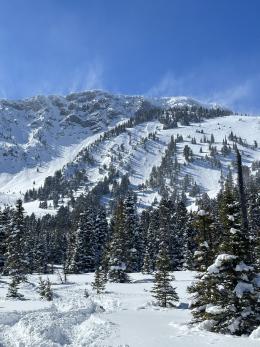Good morning. This is Doug Chabot with the Gallatin National Forest Avalanche Forecast on Wednesday, March 29th at 7:00 a.m. This information is sponsored by Advanced Innovation, Bridger Bowl, and Community Food Co-op. This forecast does not apply to operating ski areas.
At 5 a.m., the mountains received 1-2” of snow with wind averaging 10-15 mph and gusting to 25-30 mph from the SE-SW. Temperatures are in the high teens under cloudy skies. Today will remain cloudy with similar wind and temperatures. Light snowfall will start late this afternoon and drop 1-2” by tomorrow morning, with the rest of Thursday forecasted to be snowy.
The northern Gallatin Range is windier than other areas. Beginning last night gusts from the southwest are blowing 30 mph. There is 2+ feet of snow to blow around and newly formed wind slabs will be easily triggered today. Climbers need to be extra careful in gullies and skiers need to be on the lookout for any shooting cracks. On slopes not wind loaded, dig and test the top 3 feet of the snowpack to see how the new is bonding to the old surface. A few natural slides were seen that were breaking under the new snow (details and photos).
This range has also had deep and scary avalanches from weak layers 5+ feet deep that are breaking in a random way (details and photo). While rare, these slides are deadly. Notching back slope angles to below 30 degrees will keep you safe, yet if you decide to get into avalanche terrain only expose one person at a time.
The danger is rated CONSIDERABLE on wind-loaded slopes and MODERATE on all others.
Ridgetop wind is blowing SE-SW at moderate speed creating wind drifts that are being fed by last weekend’s powder (14-32”). These drifts could crack and avalanche under your feet or machine. Ian and I went into the Throne in the Bridger Range yesterday. Underneath the new snow we found a layer of facets that broke in our stability test that was also responsible for avalanche activity during and immediately after the storm (video and observation). Skiers also triggered slides outside Big Sky Ski Resort and on Little Ellis. It’s worth taking a few minutes to dig down 3 feet and test the stability before committing to avalanche terrain.
Complicating our stability assessment is the possibility of deep slab avalanches, most prominent in the southern ranges. Buried 3-5 feet deep is a weak layer that could break on a few, isolated slopes. Cooke City had more than a fair share of these, the most recent was last Thursday near Chimney Rock when 2 sledders were caught and 1 was badly injured (details and photos).
Wind-loading and a recently buried weak layer are the primary avalanche concerns today. These can be navigated with awareness and investigation of the snowpack. Slopes that could produce large, deep avalanches, on the other hand, are not easily identified. However, triggering them is most likely in thinner areas of the snowpack, but those areas are not visible on the surface. This presents a quandary. Dave explains how we can stack the deck in our favor by choosing terrain that is safer in his 2-part video series from Cooke City (part 1, part 2). In essence, either avoid avalanche terrain or choose terrain lacking traps like trees and cliffs.
The avalanche danger is rated MODERATE on all slopes.
Please share avalanche, snowpack or weather observations via our website, email (mtavalanche@gmail.com), phone (406-587-6984), or Instagram (#gnfacobs).
Ridgetop wind is blowing SW creating wind drifts that are being fed by last weekend’s 2 feet of powder. Wind-loading and a recently buried weak layer are the primary avalanche concerns today. These can be navigated with awareness and investigation of the snowpack. Slopes that could produce large, deep avalanches, on the other hand, are not easily identified.
Upcoming Avalanche Education and Events
Events and Education Calendar.
Saturday, April 1, Hyalite Canyon closes for motorized use until May 15.
Avalanches have killed 21 people in the United States so far this season. On Wednesday, March 22nd, a snowmobiler was killed in an avalanche in central Idaho. This was the eighth fatality in March.
More info on each event is available at the Avalanche.org Accidents Page.




